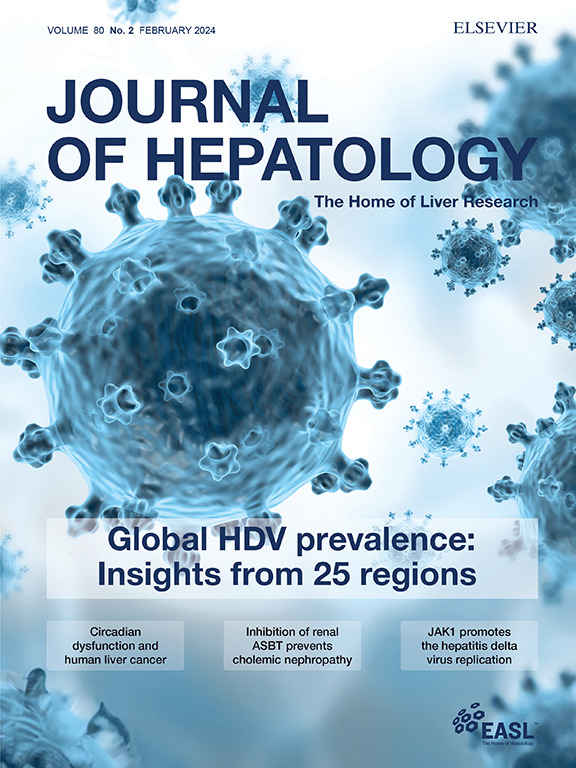瑞典13099例代谢功能障碍相关脂肪变性肝病患者的病因特异性死亡率
IF 26.8
1区 医学
Q1 GASTROENTEROLOGY & HEPATOLOGY
引用次数: 0
摘要
背景和目的代谢功能障碍相关脂肪变性肝病(MASLD)的病因特异性死亡率数据有限。我们的目的是确定与瑞典普通人群相比,MASLD患者因不同原因死亡的比率和风险。方法在这项以人群为基础的队列研究中,我们使用2002-2020年瑞典医疗保健登记册(n=13,099)识别住院或专科门诊治疗中患有MASLD的ICD-10代码的个体(n=13,099),并根据年龄、性别、城市和日历年(n=118,884)将其与普通人群中多达10名对照(中位数9)进行匹配。我们使用Cox回归来估计11种不同主要死亡原因的校正风险比(HR)和95%置信区间(CI)。计算15年累积死亡发生率,同时考虑竞争风险。结果在中位随访4.7年(四分位间距[IQR] 2.0-9.2)和5.8年(IQR 2.7-10.5)期间,MASLD患者共死亡1628例(12.4%),对照组死亡9119例(7.7%)。MASLD与较高的全因死亡率(HR=1.85, 95%CI=1.74-1.96)和除精神健康障碍以外的所有特定死因的较高死亡率相关。非肝细胞癌(HCC)肝脏相关死亡率(HR=26.9, 95%CI=19.4-37.3)和HCC相关死亡率(HR=35.0, 95%CI=17.0-72.1)的相关性最强。然而,MASLD患者15年累积死亡率最高的是非hcc癌症(7.3%)和心血管疾病(7.2%)。结论smasld与肝脏和hcc相关死亡率密切相关,但非hcc癌症和心血管疾病的绝对死亡风险最高。在MASLD患者中,几乎所有原因的死亡率都增加了,这表明需要早期的多学科治疗来降低过高的死亡率。影响和意义先前关于代谢功能障碍相关脂肪变性肝病(MASLD)患者死亡率的研究要么规模小,局限于肝脏相关死亡率,依赖肝活检来识别患者,从而导致选择偏倚,要么主要使用来自老年队列的数据。在一项针对2002年至2020年期间在瑞典住院或专科门诊诊断为MASLD的所有患者的全国性队列研究中,我们发现全因死亡率几乎翻了一番,并且由于各种原因导致的死亡率高于普通人群,这表明可能需要更早的多学科治疗来降低MASLD患者的过早死亡率。本研究中死亡的绝对风险估计可能对临床医生和政策制定者告知患者预后有用,并可能实施临床或公共卫生策略以减少过早死亡。本文章由计算机程序翻译,如有差异,请以英文原文为准。

Cause-specific mortality in 13,099 patients with metabolic dysfunction-associated steatotic liver disease in Sweden
Background and aims
Data on cause-specific mortality in metabolic dysfunction-associated steatotic liver disease (MASLD) are limited. We aimed to determine the rate and risk of death from different causes in patients with MASLD compared to the general population in Sweden.Methods
In this population-based cohort study, we identified individuals with an ICD-10 code for MASLD in inpatient or specialized outpatient care using Swedish healthcare registers 2002-2020 (n=13,099) and matched them with up to 10 controls (median 9) from the general population for age, sex, municipality, and calendar year (n=118,884). We used Cox regression to estimate adjusted hazard ratios (HR) and 95% confidence intervals (CI) for eleven different primary causes of death. 15-year cumulative incidences of death were calculated while accounting for competing risks.Results
In total, 1,628 (12.4%) deaths occurred in patients with MASLD and 9,119 (7.7%) in controls during a median follow-up of 4.7 (interquartile range [IQR] 2.0-9.2) and 5.8 years (IQR 2.7-10.5), respectively. MASLD was associated with higher all-cause mortality (HR=1.85, 95%CI=1.74-1.96) and higher rates of all specific causes of death except mental health disorder. The strongest associations were observed for non-hepatocellular carcinoma (HCC) liver-related (HR=26.9, 95%CI=19.4-37.3) and HCC-related mortality (HR=35.0, 95%CI=17.0-72.1). However, the highest estimated 15-year cumulative incidence of death in patients with MASLD was for non-HCC cancer (7.3%) and cardiovascular disease (7.2%).Conclusions
MASLD was strongly associated with liver- and HCC-related mortality, but the absolute risks of death were highest for non-HCC cancer and cardiovascular disease. Mortality was increased for nearly all causes in patients with MASLD, suggesting that earlier multidisciplinary care is needed to reduce excess mortality.Impact and implications
Previous studies on mortality in patients with metabolic dysfunction-associated steatotic liver disease (MASLD) were either small, restricted to liver-related mortality, relying on liver biopsy to identify patients and thus inducing selection bias, or mainly using data from old cohorts. In a nationwide cohort study of all patients diagnosed with MASLD in inpatient or specialized outpatient care in Sweden between 2002 and 2020, we found a nearly doubled all-cause mortality rate and higher mortality than the general population from a wide range of causes, indicating that earlier multidisciplinary care may be needed to reduce premature mortality in patients with MASLD. The absolute risk estimates of death in our study may be useful for clinicians and policymakers to inform patients about their prognosis and potentially implement clinical or public health strategies to reduce premature mortality.求助全文
通过发布文献求助,成功后即可免费获取论文全文。
去求助
来源期刊

Journal of Hepatology
医学-胃肠肝病学
CiteScore
46.10
自引率
4.30%
发文量
2325
审稿时长
30 days
期刊介绍:
The Journal of Hepatology is the official publication of the European Association for the Study of the Liver (EASL). It is dedicated to presenting clinical and basic research in the field of hepatology through original papers, reviews, case reports, and letters to the Editor. The Journal is published in English and may consider supplements that pass an editorial review.
 求助内容:
求助内容: 应助结果提醒方式:
应助结果提醒方式:


